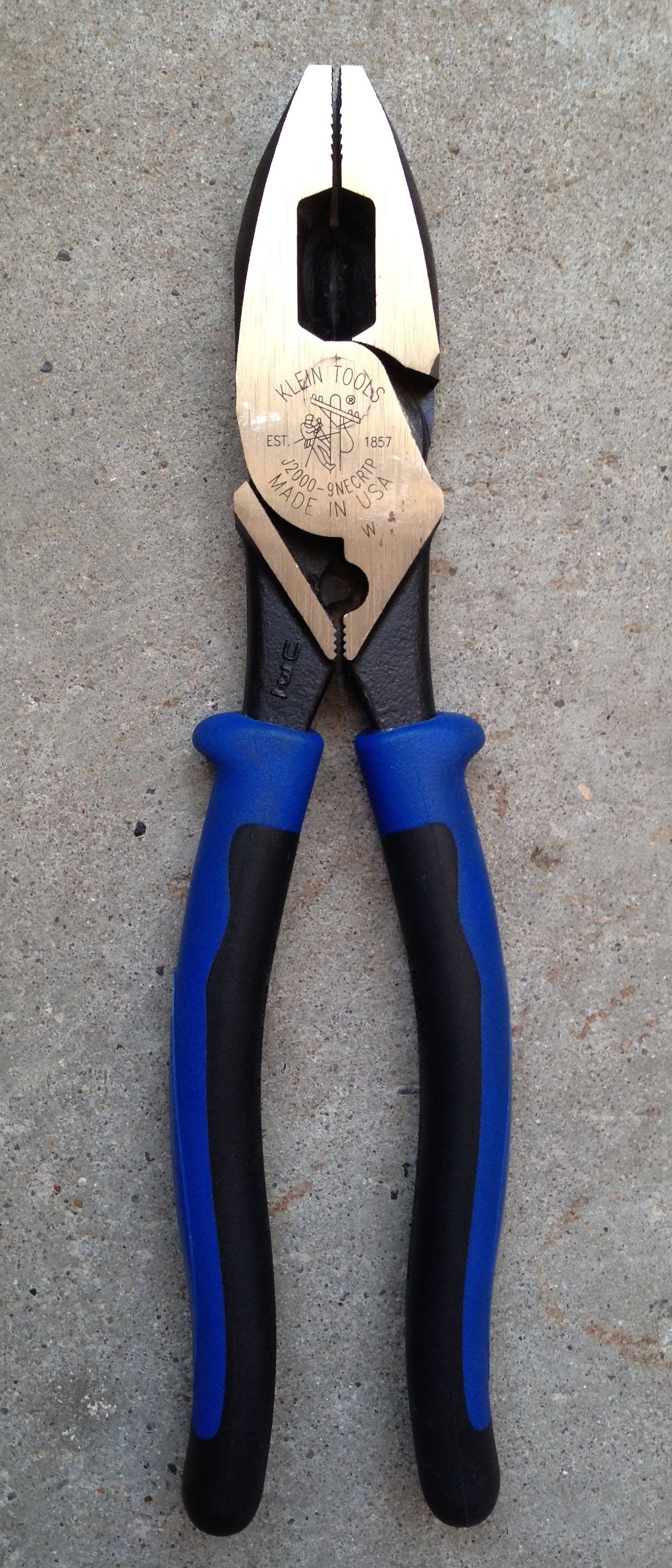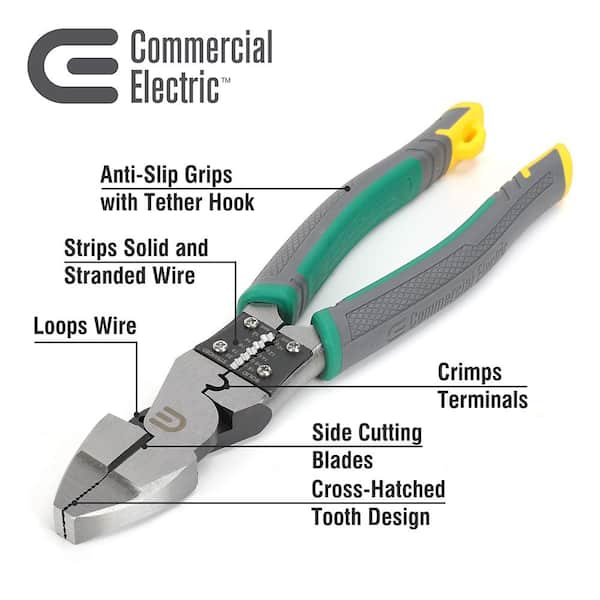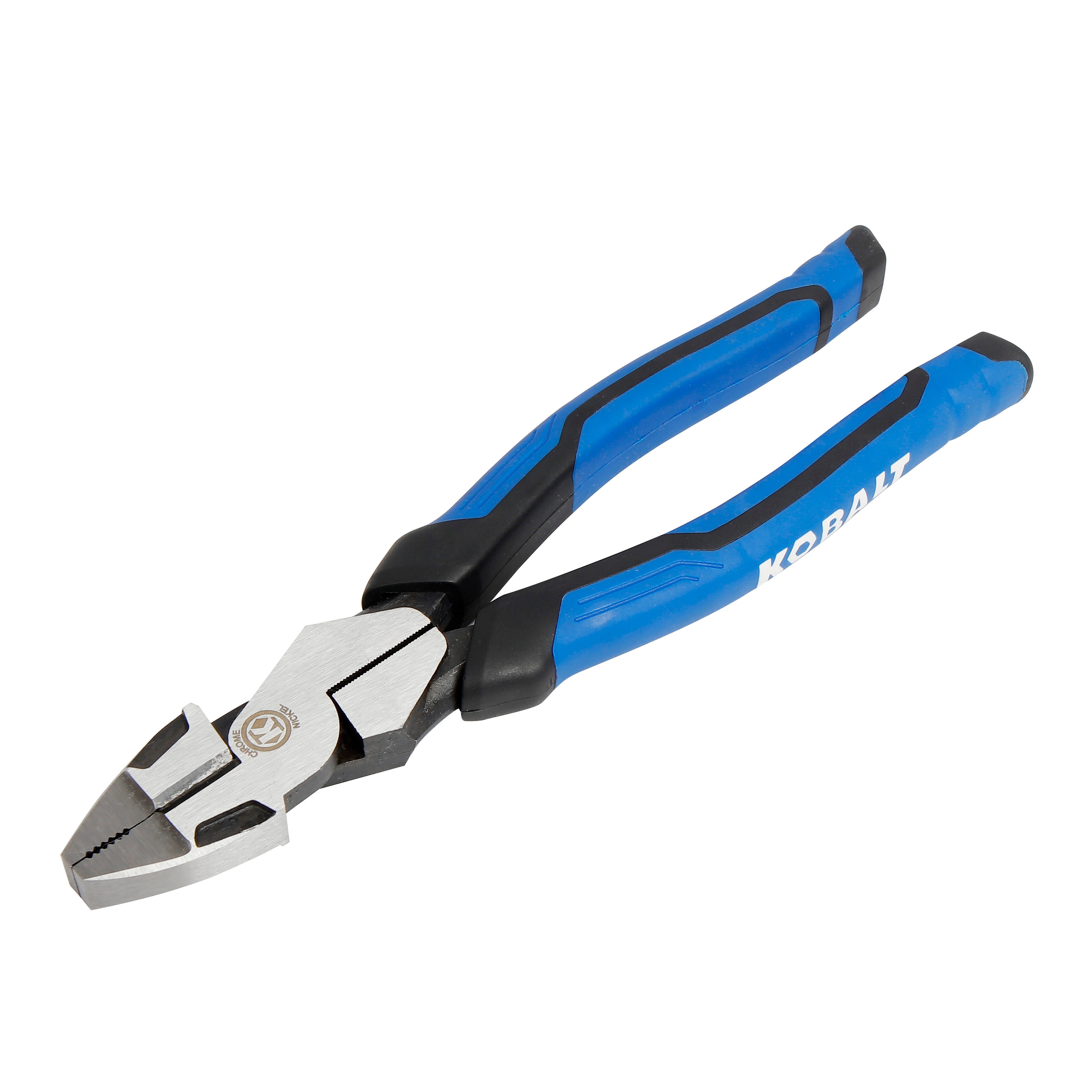Lineman’s pliers are versatile hand tools used for gripping, bending, and cutting wire. They are essential in electrical work.
Lineman’s pliers, also known as combination pliers, have become indispensable tools for electricians and tradespeople. Their robust design allows for effective gripping, twisting, and cutting of wires, making them perfect for electrical installations and repairs. The pliers feature a flat nose for twisting wires and a cutting edge for trimming.
The high leverage design ensures maximum force with minimal effort, enhancing efficiency and precision. Their durable construction, often made from high-carbon steel, ensures longevity and reliability. Lineman’s pliers are crucial for both professional electricians and DIY enthusiasts, offering versatility and durability in one compact tool.

Credit: en.wikipedia.org
Introduction To Lineman’s Pliers
Lineman’s pliers are essential tools in electrical work. They have gripping, twisting, bending, and cutting capabilities. These versatile tools are indispensable for electricians.
History And Evolution
The history of lineman’s pliers dates back to the early 19th century. Over time, they have evolved to meet modern needs. Initially, they were simple gripping tools.
In the late 1800s, manufacturers added cutting edges. This made them more useful for wire work. By the 20th century, lineman’s pliers had become standard for electricians.
Today, they feature insulated handles and ergonomic designs. These improvements ensure safety and comfort during use.
Importance In Electrical Work
Lineman’s pliers are crucial for various electrical tasks. They can cut, strip, and twist wires with ease. Their gripping jaws hold wires firmly.
Electricians use them to make secure connections. They also use them to remove old wiring. The cutting edges are sharp and durable.
Insulated handles protect against electric shocks. This makes them safe for high-voltage work.
| Feature | Benefit |
|---|---|
| Gripping Jaws | Hold wires firmly |
| Cutting Edges | Cut wires cleanly |
| Insulated Handles | Protect against shocks |
Lineman’s pliers are also useful for non-electrical tasks. They can bend and shape metal parts. Their versatility makes them a must-have in any toolbox.
Overall, lineman’s pliers are indispensable for electrical work. Their history and evolution reflect their importance.
Key Features
Lineman’s pliers are essential tools for electricians and DIY enthusiasts. They offer various features that make them indispensable. In this section, we will explore the key features of these versatile tools.
Design And Structure
The design and structure of lineman’s pliers are crucial for their functionality. These pliers have a strong, robust build to handle tough jobs.
- Long Handles: Provide leverage for cutting and gripping.
- Flat Nose: Ideal for twisting wires and gripping objects.
- Cutting Edge: Sharp and durable for cutting wires and cables.
- Insulated Handles: Ensure safety while working with electrical wires.
The combination of these features makes lineman’s pliers versatile and reliable.
Materials Used
The materials used in lineman’s pliers determine their durability and strength. High-quality materials ensure long-lasting performance.
| Material | Purpose |
|---|---|
| High-Carbon Steel | Offers strength and durability. |
| Chromium-Vanadium Steel | Provides resistance to corrosion and wear. |
| Plastic or Rubber | Used for insulated handles for safety. |
These materials ensure that lineman’s pliers can withstand heavy use and harsh conditions.
Types Of Lineman’s Pliers
Lineman’s pliers are essential tools for electricians. They come in different types, each with unique features and benefits. Understanding these types helps in selecting the right tool for the job.
Standard Pliers
Standard pliers are the most common type. They are versatile and used for various tasks. These pliers have strong jaws for gripping, twisting, and cutting wires. Their design includes a cutting edge and gripping teeth.
Here are some features of standard pliers:
- Durable and made of high-quality steel.
- Have a cutting edge near the pivot.
- Features gripping teeth on the jaws.
Standard pliers are ideal for general electrical work. They are a must-have for any electrician’s toolkit.
Insulated Pliers
Insulated pliers are designed for safety. They have a protective coating that prevents electric shocks. These pliers are essential for working with live wires. The insulation ensures the user’s safety from electrical hazards.
Key features of insulated pliers include:
- Insulated handles to protect against electric shocks.
- Made of high-quality materials for durability.
- Suitable for live wire work.
Insulated pliers are crucial for high-voltage electrical work. They provide safety and reliability in dangerous environments.

Credit: www.homedepot.com
Primary Uses
Lineman’s pliers are essential tools in various electrical tasks. These versatile pliers offer multiple functionalities that make them indispensable for professionals. Below, we explore the primary uses of lineman’s pliers in detail.
Cutting Wires
Lineman’s pliers excel at cutting wires with precision. The sharp, hardened cutting edges allow for smooth and clean cuts. They can easily cut through:
- Electrical wires
- Steel wires
- Bolts and screws
These pliers are designed to handle various gauges of wire. Their strength ensures efficiency and safety during cutting tasks.
Bending And Shaping
Bending and shaping wires is another primary use of lineman’s pliers. The flat, serrated jaws provide a strong grip, making it easy to manipulate wires. This is especially useful for:
- Creating loops
- Forming hooks
- Twisting wires together
These tasks are vital in electrical installations and repairs. The pliers’ ergonomic design also reduces hand fatigue, enhancing productivity.
Advanced Applications
Lineman’s pliers are indispensable tools for electricians and DIY enthusiasts. They offer various advanced applications that go beyond basic wire cutting and gripping. This section delves into two of these advanced uses: Crimping Connectors and Pulling Fish Tape.
Crimping Connectors
Many lineman’s pliers come with a built-in crimping tool. This feature makes it easy to secure connectors to wires. Crimping connectors ensures a strong electrical connection. Follow these steps to crimp connectors with your pliers:
- Strip the wire to expose the metal.
- Insert the wire into the connector.
- Place the connector in the crimping slot of your pliers.
- Squeeze the pliers tightly to crimp the connector.
Using lineman’s pliers for crimping saves time and effort. It also ensures a reliable connection.
Pulling Fish Tape
Pulling fish tape through conduit can be challenging. Lineman’s pliers make this task easier. The strong grip of these pliers helps pull the tape smoothly. Here’s how to do it:
- Feed the fish tape into the conduit.
- Attach the end of the tape to the wire.
- Use your pliers to grip the tape firmly.
- Pull the tape and wire through the conduit.
Using lineman’s pliers for pulling fish tape reduces hand fatigue. It also provides a secure grip, making the process faster.
Here’s a quick comparison of features:
| Feature | Benefit |
|---|---|
| Crimping Connectors | Ensures strong electrical connections |
| Pulling Fish Tape | Reduces hand fatigue and provides secure grip |
These advanced applications make lineman’s pliers a versatile tool for any toolkit.
Maintenance Tips
Maintaining your lineman’s pliers ensures they last longer and function better. Proper care will keep them in top condition. Follow these simple tips to maintain your pliers.
Cleaning And Lubrication
Regular cleaning is essential. Use a brush to remove dirt and debris.
- First, wipe the pliers with a dry cloth.
- Use a small brush for stubborn dirt.
- Apply a few drops of machine oil to the joints.
- Open and close the pliers to spread the oil evenly.
- Wipe off any excess oil with a cloth.
Lubrication prevents rust and ensures smooth operation. Never skip this step.
Storage Recommendations
Proper storage of your lineman’s pliers is crucial. Store them in a dry place to avoid rust.
- Keep them in a tool box or a drawer.
- Use a silicone gel packet to absorb moisture.
- Hang them on a pegboard for easy access.
- Ensure they are not touching other tools.
- Avoid storing them in damp areas.
Always store your pliers with the jaws closed. This prevents damage to the cutting edges. Proper storage extends the life of your pliers.
Safety Considerations
Using Lineman’s Pliers requires attention to safety. Proper handling techniques and avoiding electrical hazards are crucial. This helps prevent accidents and ensures your safety.
Proper Handling Techniques
Proper handling of Lineman’s Pliers is important for safety. Always hold the pliers with a firm grip. This ensures you have control and prevents slips.
- Use both hands for better control when cutting or twisting wires.
- Keep your fingers away from the cutting edge to avoid injuries.
- Store pliers properly after use to prevent accidents.
Wearing gloves can also protect your hands from cuts and abrasions. Make sure to choose gloves that fit well and provide good grip.
Avoiding Electrical Hazards
Working with Lineman’s Pliers near electrical sources requires caution. Always assume that wires may be live.
- Turn off the power before working on electrical circuits.
- Use insulated pliers to protect against electric shocks.
- Check the insulation of the pliers before use.
Never use damaged or worn-out pliers. Inspect your tools regularly to ensure they are in good condition. This helps in preventing unexpected electrical hazards.
By following these safety considerations, you can use Lineman’s Pliers effectively and safely.

Credit: www.lowes.com
Choosing The Right Pliers
Choosing the right lineman’s pliers can make your job easier. Pliers are essential for electricians, mechanics, and DIY enthusiasts. The right pair ensures safety, efficiency, and precision. Below, we explore the key factors to consider and top brands to help you make an informed choice.
Factors To Consider
- Material: Choose pliers made from high-quality steel. This ensures durability and strength.
- Grip: Look for pliers with comfortable, non-slip handles. This reduces hand fatigue and improves control.
- Jaw Design: The jaws should be sharp and well-aligned. This ensures clean cuts and firm grips.
- Size: Select the size that fits your hand comfortably. Smaller pliers are better for precision work, while larger ones offer more leverage.
- Insulation: If working with electricity, choose insulated pliers. This adds an extra layer of safety.
- Price: Balance cost with quality. Investing in a good pair saves money in the long run.
Top Brands
| Brand | Features |
|---|---|
| Klein Tools | High-quality steel, comfortable grip, excellent insulation |
| Channellock | Durable, precise jaw alignment, affordable |
| Knipex | German engineering, sharp jaws, ergonomic design |
| Irwin | Strong build, non-slip handles, versatile |
| Milwaukee | High leverage, rust-resistant, comfortable grip |
Choosing the right pliers is crucial for any task. Always consider material, grip, and jaw design. Top brands like Klein Tools and Knipex offer reliability and quality. Ensure your pliers suit your specific needs for the best results.
Frequently Asked Questions
What Are Lineman’s Pliers Used For?
Lineman’s pliers are used for gripping, twisting, bending, and cutting wires. They are essential tools for electricians.
What Is The Difference Between Linesman Pliers And Regular Pliers?
Linesman pliers have a flat gripping surface and cutting edge. Regular pliers may lack the cutting feature. Linesman pliers handle tougher jobs like cutting wires.
What Is The Nickname For Lineman Pliers?
The nickname for lineman pliers is “side cutters” or “linesman pliers. ” They are essential tools for electricians.
What Is The Real Name Of Lineman Pliers?
The real name of lineman pliers is “combination pliers. ” These tools are versatile and widely used in electrical work.
Conclusion
Lineman’s pliers are essential for any toolbox. They offer strength and versatility for various tasks. Investing in a high-quality pair ensures durability and efficiency. Remember to choose pliers with ergonomic handles for comfort. With the right lineman’s pliers, your electrical and general projects will be much easier and more efficient.


